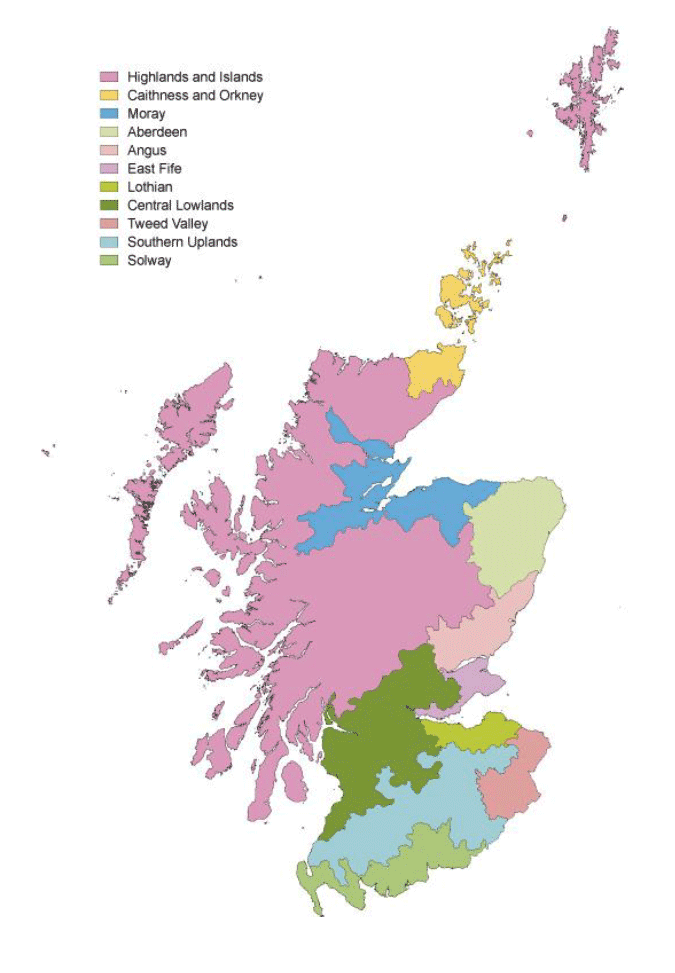Pesticide Usage in Scotland: Protected Edible Crops 2015 - Summary Report
Report on a survey of pesticide use on protected edible crops in Scotland.
This document is part of a collection
Appendix 4 - Survey methodology
Sampling and data collection
Using the June 2015 Agricultural Census 7 a sample was drawn from growers of protected edible crops, these being any edible crop grown within a glasshouse or permanent polytunnel. Crops grown under temporary structures such as French or Spanish tunnels were excluded. For 2015 this involved selecting from growers who recorded crop areas in the 'Tomatoes' or 'Vegetables' categories within the glasshouses and walk-in plastic structures' section of the Agricultural Census Form. For the purpose of sampling, the country was divided into 11 land-use regions as shown in Figure 9. The sample was stratified by region and according to holding size, and sampling within holding size groups was based on area rather than numbers of holdings, so that smaller holdings were not over-represented in the sample.
The survey period covered pesticide applications to crops during the 12 month period from October 2014 to September 2015. Following an introductory letter and telephone call, data were collected by either personal interview during a visit to the holding or via a telephone interview. In total, information was collected from 16 holdings ( Table 14 & 16). These 16 holdings collectively grew 16 per cent of the census crop area.
Raising factors
National pesticide use was estimated by ratio raising. This is a standard statistical technique for producing estimates from a sample. It is the same methodology used by the other UK survey teams and has been used for all historical datasets produced by the Pesticide Survey Unit, allowing comparability over time. The sample data were multiplied by raising factors ( Table 15). These factors were calculated by comparing the sampled tomato and vegetable cropped areas to the areas recorded in the Agricultural Census. Due to a combination of small sample size, the wide range of crops encountered and there being little regional variation in pesticide use within protected edible crops, raising factors were calculated at a national rather than a regional level and without taking into account holding size.
Figure 9 Land use regions of Scotland 8

Changes from previous years
There are a number of changes which should be noted when comparing the 2015 data with the previous survey.
The term active substance is now used instead of active ingredient which appeared in previous reports. This change makes the Scottish reports consistent with the UK pesticide usage reports.
The biological data has been split for the first time into both biological control agents and biopesticides. Biopesticides require to be authorised like other pesticides, whereas biological control agents do not (see section 3 definitions and notes for details). As it is not always possible to collect rates for biological control agents, their quantities are unknown and are therefore not included in weight tables. Rates are available for biopesticides and quantity data are provided.
Another change to note is that sulphur was previously reported as a fungicide. It is now reported in a category on its own to acknowledge that as well as being used as a fungicide, it has other functions in some crops. In order to allow comparison with previous surveys, fungicide data from the 2013 and 2011 surveys included in this report have been recalculated to exclude sulphur.
The 2015 report also presents a number of new reports of pesticide use pattern to help improve data quality for users. Information relating to pesticide application timings can be found in figure 5. Data relating to the average number of applications can be found in figure 6. There is also a new section reporting integrated pest management techniques used by growers i.e. for the first time the reports include information about non chemical methods growers use to control pests, weeds and diseases (see appendix 6).
Data quality assurance
The data undergo several validation processes as follows; (i) checking for any obvious errors upon data receipt (ii) checking and identifying inconsistencies with use and pesticide approval conditions once entered into the database (iii) 100 per cent checking of data held in the database against the raw data. Where inconsistencies are found these are checked against the records and with the grower if necessary. Additional quality assurance is provided by sending reports for review to members of the Working Party on Pesticide Usage Surveys and other agricultural experts. In addition, the Scottish pesticide survey unit is accredited to ISO 9001:2008. All survey related processes are documented in Standard Operating Procedures ( SOPs) and our output is audited against these SOPs by internal auditors annually and by external auditors every three years.
Main sources of bias
A stratified random sample, grouped by farm size and region, is used to select holdings used in this survey. Sampling within size groups is based on area rather than numbers of holdings, so that smaller size groups are not over-represented in the sample. The pesticide survey may be subject to measurement bias as it is reliant on farmers/growers recording data accurately. As this survey is not compulsory it may also be subject to non-response bias, as growers on certain farm/holding types may be more likely to respond to the survey than others. Reserve lists of holdings are held for each stratum to allow non-responding holdings to be replaced with similar holdings.
Experience indicates that stratified random sampling, including reserves, coupled with personal interview technique, delivers the highest quality sample data and minimises non-response bias.
Contact
There is a problem
Thanks for your feedback